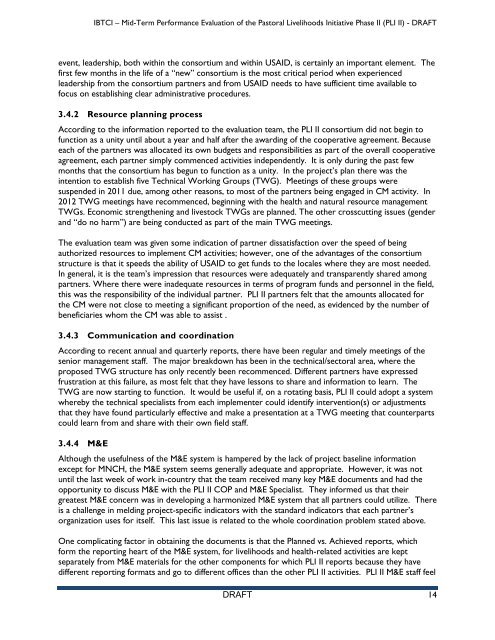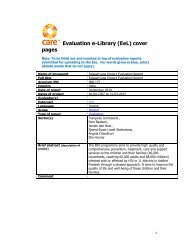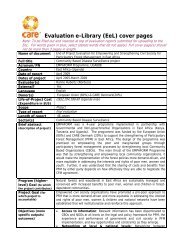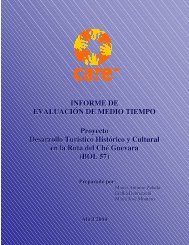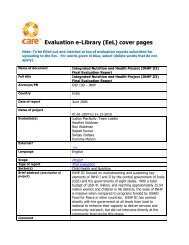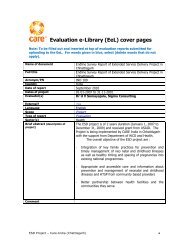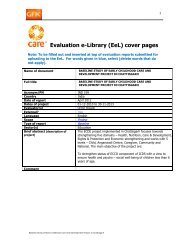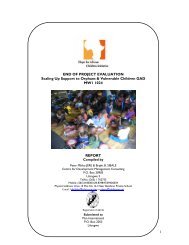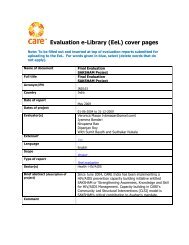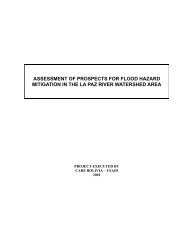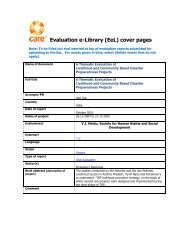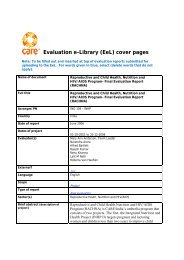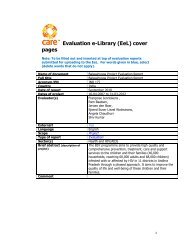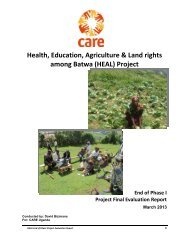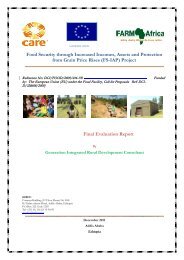Mid Term EVALUATION PLI II project - CARE International's ...
Mid Term EVALUATION PLI II project - CARE International's ...
Mid Term EVALUATION PLI II project - CARE International's ...
You also want an ePaper? Increase the reach of your titles
YUMPU automatically turns print PDFs into web optimized ePapers that Google loves.
IBTCI – <strong>Mid</strong>-<strong>Term</strong> Performance Evaluation of the Pastoral Livelihoods Initiative Phase <strong>II</strong> (<strong>PLI</strong> <strong>II</strong>) - DRAFT<br />
event, leadership, both within the consortium and within USAID, is certainly an important element. The<br />
first few months in the life of a “new” consortium is the most critical period when experienced<br />
leadership from the consortium partners and from USAID needs to have sufficient time available to<br />
focus on establishing clear administrative procedures.<br />
3.4.2 Resource planning process<br />
According to the information reported to the evaluation team, the <strong>PLI</strong> <strong>II</strong> consortium did not begin to<br />
function as a unity until about a year and half after the awarding of the cooperative agreement. Because<br />
each of the partners was allocated its own budgets and responsibilities as part of the overall cooperative<br />
agreement, each partner simply commenced activities independently. It is only during the past few<br />
months that the consortium has begun to function as a unity. In the <strong>project</strong>’s plan there was the<br />
intention to establish five Technical Working Groups (TWG). Meetings of these groups were<br />
suspended in 2011 due, among other reasons, to most of the partners being engaged in CM activity. In<br />
2012 TWG meetings have recommenced, beginning with the health and natural resource management<br />
TWGs. Economic strengthening and livestock TWGs are planned. The other crosscutting issues (gender<br />
and “do no harm”) are being conducted as part of the main TWG meetings.<br />
The evaluation team was given some indication of partner dissatisfaction over the speed of being<br />
authorized resources to implement CM activities; however, one of the advantages of the consortium<br />
structure is that it speeds the ability of USAID to get funds to the locales where they are most needed.<br />
In general, it is the team’s impression that resources were adequately and transparently shared among<br />
partners. Where there were inadequate resources in terms of program funds and personnel in the field,<br />
this was the responsibility of the individual partner. <strong>PLI</strong> <strong>II</strong> partners felt that the amounts allocated for<br />
the CM were not close to meeting a significant proportion of the need, as evidenced by the number of<br />
beneficiaries whom the CM was able to assist .<br />
3.4.3 Communication and coordination<br />
According to recent annual and quarterly reports, there have been regular and timely meetings of the<br />
senior management staff. The major breakdown has been in the technical/sectoral area, where the<br />
proposed TWG structure has only recently been recommenced. Different partners have expressed<br />
frustration at this failure, as most felt that they have lessons to share and information to learn. The<br />
TWG are now starting to function. It would be useful if, on a rotating basis, <strong>PLI</strong> <strong>II</strong> could adopt a system<br />
whereby the technical specialists from each implementer could identify intervention(s) or adjustments<br />
that they have found particularly effective and make a presentation at a TWG meeting that counterparts<br />
could learn from and share with their own field staff.<br />
3.4.4 M&E<br />
Although the usefulness of the M&E system is hampered by the lack of <strong>project</strong> baseline information<br />
except for MNCH, the M&E system seems generally adequate and appropriate. However, it was not<br />
until the last week of work in-country that the team received many key M&E documents and had the<br />
opportunity to discuss M&E with the <strong>PLI</strong> <strong>II</strong> COP and M&E Specialist. They informed us that their<br />
greatest M&E concern was in developing a harmonized M&E system that all partners could utilize. There<br />
is a challenge in melding <strong>project</strong>-specific indicators with the standard indicators that each partner’s<br />
organization uses for itself. This last issue is related to the whole coordination problem stated above.<br />
One complicating factor in obtaining the documents is that the Planned vs. Achieved reports, which<br />
form the reporting heart of the M&E system, for livelihoods and health-related activities are kept<br />
separately from M&E materials for the other components for which <strong>PLI</strong> <strong>II</strong> reports because they have<br />
different reporting formats and go to different offices than the other <strong>PLI</strong> <strong>II</strong> activities. <strong>PLI</strong> <strong>II</strong> M&E staff feel<br />
DRAFT 14


